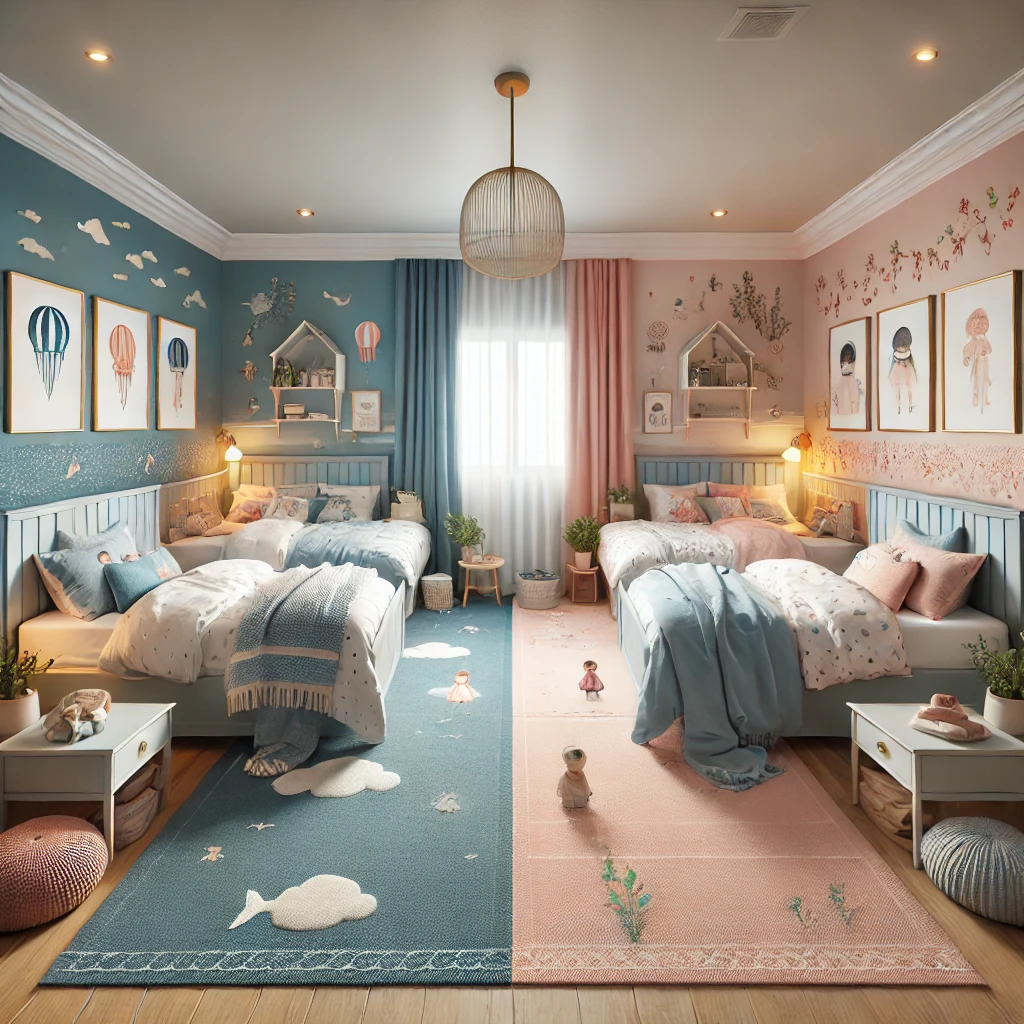Siblings Day shared bedroom; Siblings Day is a wonderful occasion to celebrate the special bond between brothers and sisters. One of the best ways to honor this day is by giving their shared bedroom a fresh and exciting makeover. A well-decorated room can foster creativity, personal expression, and harmony between siblings.
Sharing a room can sometimes lead to small conflicts over space and style. However, with thoughtful décor ideas, you can create a space that balances both individuality and togetherness. This article covers 18 creative ways to transform a shared sibling bedroom, making it both functional and fun.
From space-saving solutions to playful décor enhancements, these ideas cater to different preferences and room sizes. Whether your goal is to improve organization, create personalized zones, or add a fun and cozy atmosphere, these tips will help you achieve a beautiful and practical sibling-friendly space.
Section 1: Smart Space-Saving Solutions
1. Bunk Beds with Storage

Bunk beds are a fantastic way to save space while adding a fun element to the room. Many modern bunk beds come with built-in storage drawers or shelves, making it easier to keep toys, books, and clothes organized. This setup allows for a more open floor plan, perfect for playing and moving around.
Another great feature of bunk beds is that they offer each sibling a designated sleeping area. This helps maintain personal space while still sharing a room. Choosing a design with curtains or side panels can also provide extra privacy.
If bunk beds aren’t an option, consider trundle beds, which slide under the main bed when not in use. These are perfect for small rooms and can be pulled out whenever needed. Multi-functional furniture like this ensures the room remains spacious and tidy.
2. Loft Beds with Study/Play Area

Loft beds are a clever way to maximize vertical space in a shared bedroom. By raising the bed, you create additional room underneath for a study desk, play area, or extra storage. This setup works particularly well for older siblings who need a quiet place to study.
A loft bed with a study nook underneath allows both siblings to focus on their tasks without distractions. You can personalize the space by adding wall organizers, floating shelves, and task lighting. This encourages productivity while keeping the rest of the room clutter-free.
For younger siblings, the space under a loft bed can be turned into a cozy reading nook or a mini playhouse. Adding soft rugs, cushions, and fairy lights can make it a fun hideaway. This way, both practicality and creativity are balanced in the shared space.
3. Under-Bed Storage Drawers
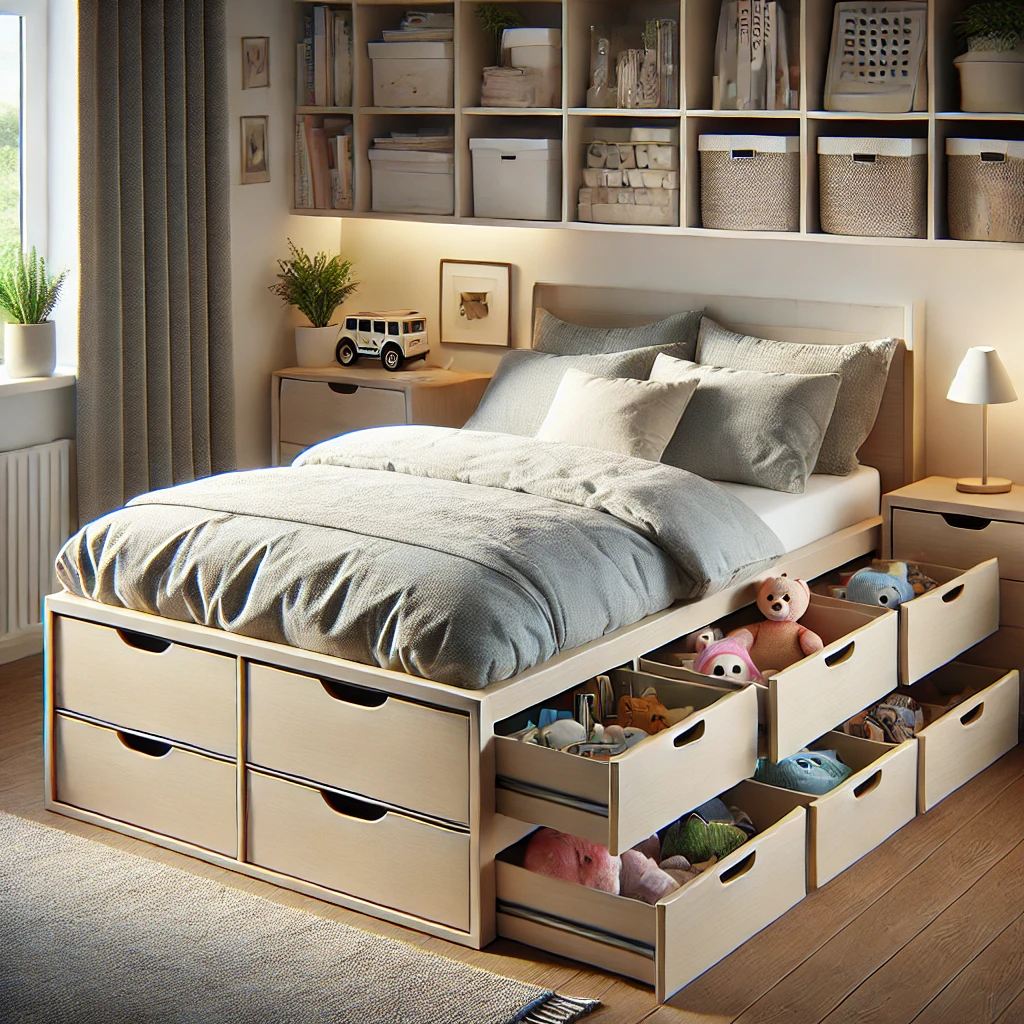
Maximizing storage is essential in a shared bedroom, and under-bed drawers offer a perfect solution. These drawers help store seasonal clothing, toys, or school supplies without taking up extra space. With proper organization, each sibling can have their own designated storage section.
Clear plastic bins or fabric storage boxes can be used to separate items neatly. Labeling the bins makes it easy for younger children to find their belongings. This system encourages responsibility and reduces clutter around the room.
If you’re short on space, consider beds with built-in pull-out drawers. Some designs even come with dividers to help siblings organize their things better. This simple yet effective storage solution keeps the room looking tidy and functional.
4. Shared Closet Organizers

Closet space can become a source of tension in a shared bedroom, but a well-organized system can help. Using double-hanging rods allows both siblings to have equal closet space. Drawer dividers, baskets, and labeled shelves make it easier to keep everything sorted.
Color-coding clothes by sibling can help avoid mix-ups. For example, one child’s clothes can be on the left while the other’s are on the right. This organization system ensures that both have equal storage without unnecessary arguments.
Hanging shoe organizers or vertical storage racks are also great for maximizing closet space. These allow for extra storage without taking up more room. A properly arranged closet makes it easier for siblings to find their belongings while keeping things neat.
5. Foldable & Stackable Furniture
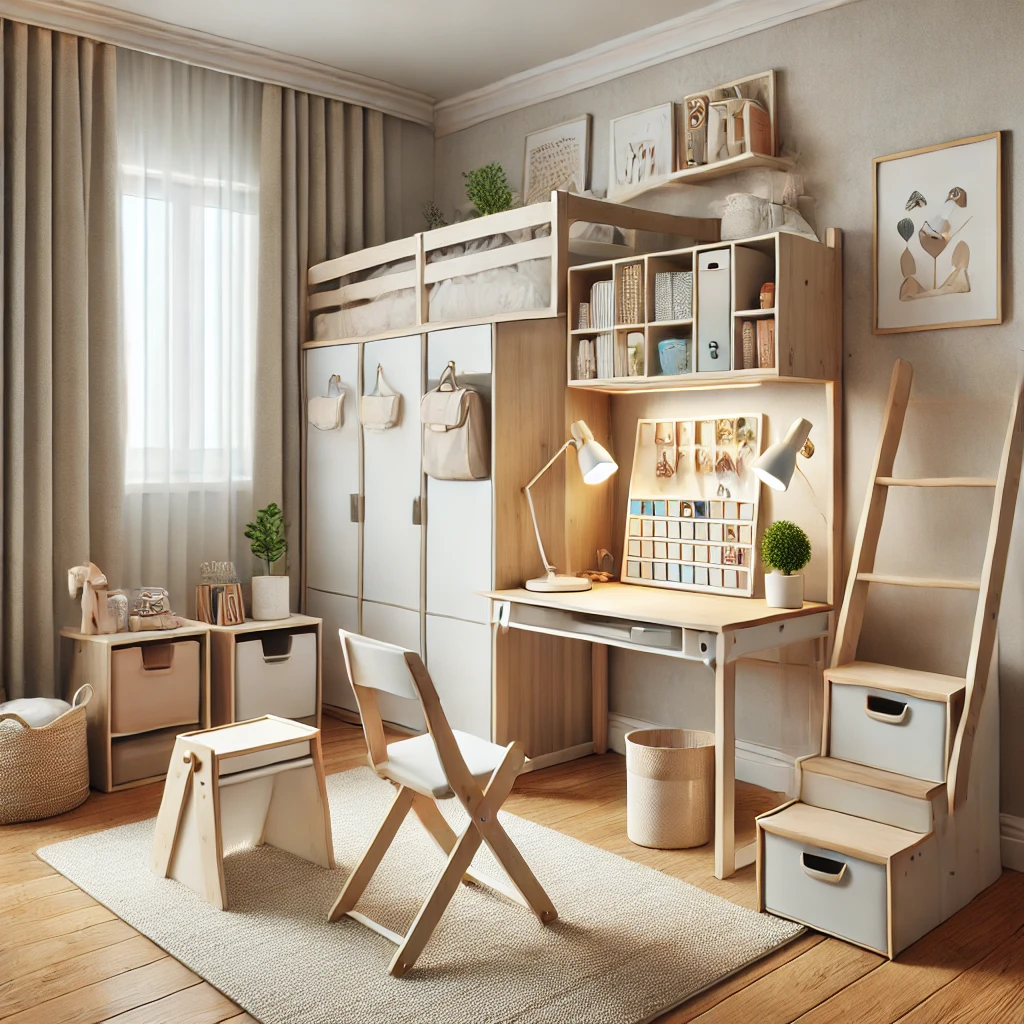
Foldable and stackable furniture is ideal for shared rooms with limited space. Stackable chairs, foldable desks, or wall-mounted tables can be used as needed and tucked away when not in use. This ensures that the room remains spacious and flexible.
Murphy beds or fold-out desks are another space-saving solution. They can be folded away when not in use, providing extra play or activity space during the day. Such furniture designs promote better room functionality without compromising on style.
Another creative idea is using stackable stools instead of large chairs. These can be easily stored when not needed and brought out for activities like arts and crafts. Keeping furniture compact and adaptable makes a shared room much more practical.
Section 2: Personalized Zones for Each Sibling
6. Separate Color Schemes or Themes
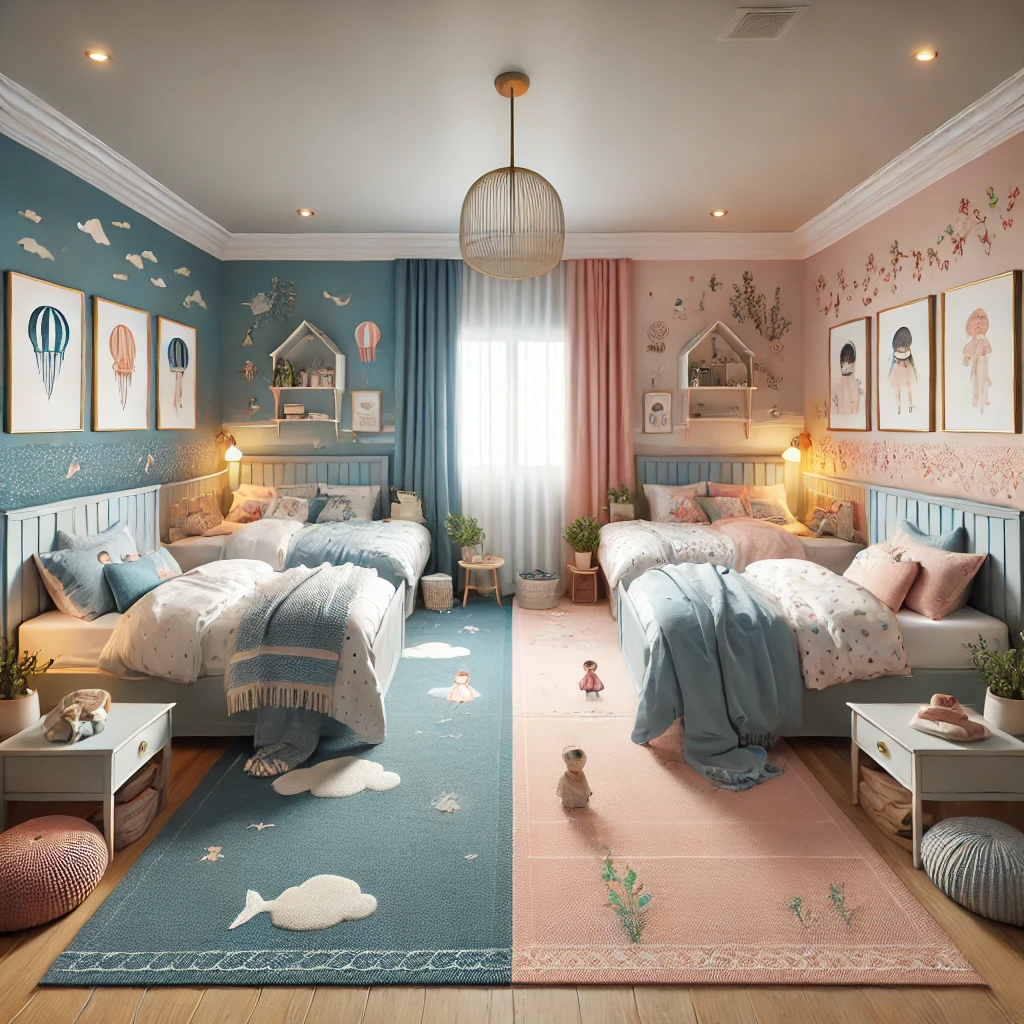
Even in a shared bedroom, each sibling should have their own personal touch. Using different color schemes on each side of the room helps define individual spaces. This can be done with different bedding, wall decals, or furniture colors.
For example, one sibling might prefer cool blue tones, while the other likes warm pink hues. Instead of painting the whole room differently, use accent walls, curtains, or rugs to showcase personal preferences. This keeps the room visually cohesive while allowing each sibling to express themselves.
If the siblings agree on a common theme, like space exploration or nature, the room can have a unified design with small individual touches. This creates a shared space that still respects individuality.
7. Name or Initial Wall Art
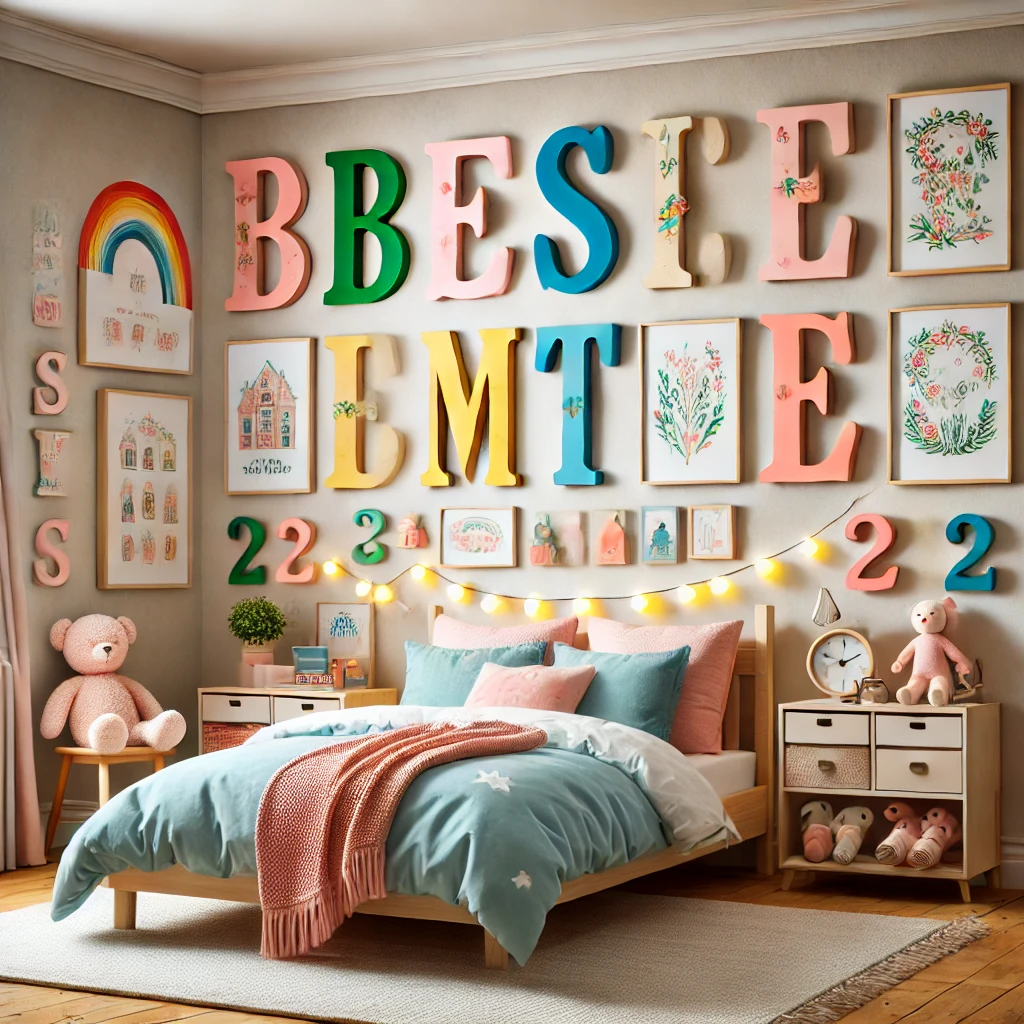
Personalized décor helps make a shared room feel more special. Adding each sibling’s name or initials to their side of the room can be a simple yet meaningful touch. This can be done using wooden letters, neon signs, or vinyl decals.
Wall art with their favorite quotes or characters can also add a unique element. This way, they feel a sense of ownership over their side of the room. Allowing them to choose the design ensures that their personal style is reflected in the space.
DIY name art projects can be a fun sibling bonding activity. Painting wooden letters or creating a name collage together can add a personal touch while making memories. This type of décor is an easy way to make the room feel special.
8. Twin Desks for Homework & Creativity
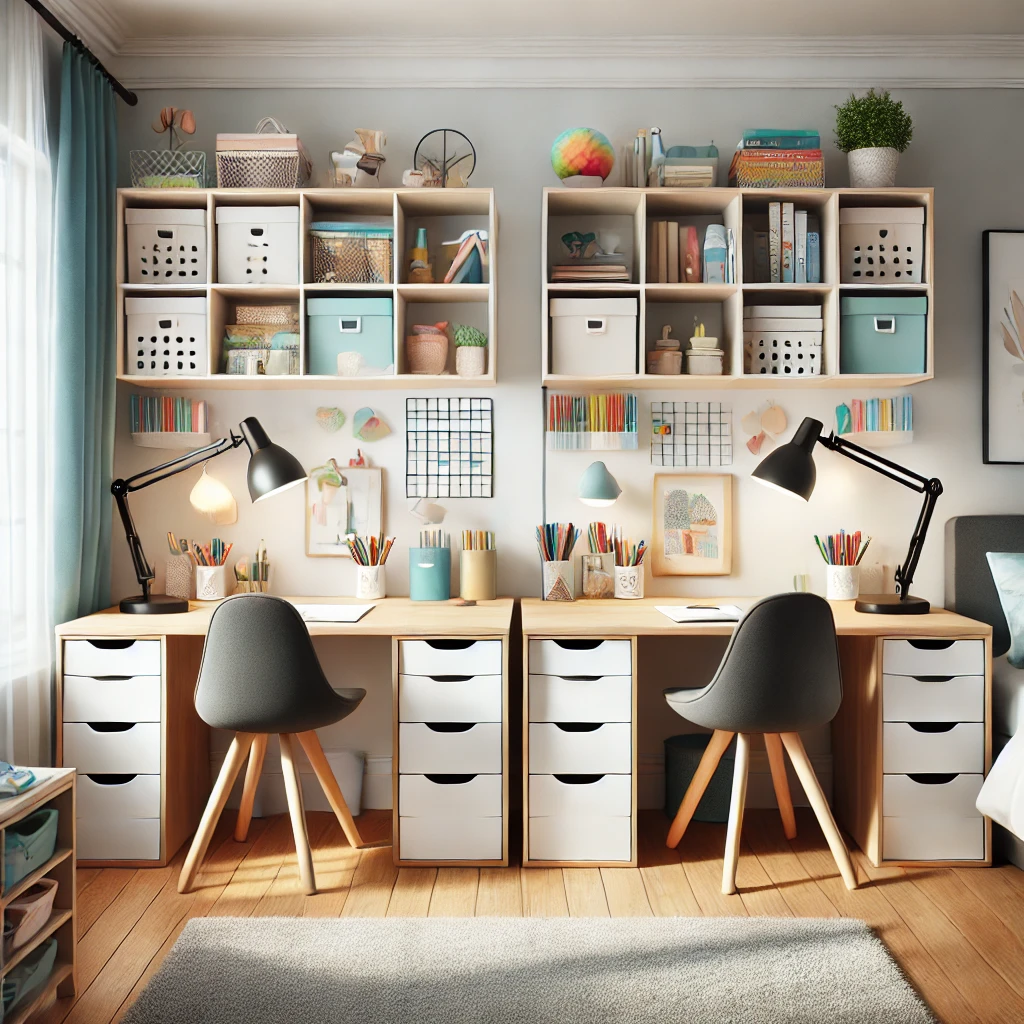
A dedicated study area helps siblings focus on their homework and creative projects. Twin desks placed side by side create a productive environment while maintaining individual workspaces. This setup ensures that both children have enough room to study comfortably.
Adding personal desk accessories, like unique lamps or stationery holders, helps define each workspace. Desk organizers can keep supplies tidy, preventing clutter and distractions. If space is tight, a long shared desk with dividers can also work.
Encouraging personalized study spaces fosters good habits. Each child can decorate their area with motivational quotes, small plants, or framed artwork. A well-designed study zone boosts focus and creativity in a shared bedroom.
9. Room Dividers or Curtains

Creating separate zones within a shared room can help give each sibling a sense of privacy. Using room dividers, curtains, or bookshelves to section off each child’s space can make the room feel more personalized. This setup works especially well for siblings with different schedules or hobbies.
Curtains or canopy dividers are a simple and flexible option. They can be drawn when privacy is needed and opened when siblings want to interact. This way, each sibling has their own space without completely isolating themselves from each other.
Bookshelves or open shelving units can act as both a divider and extra storage. This solution allows each child to have a designated side while keeping books, toys, or decorations neatly displayed. A well-placed divider keeps the room organized while maintaining an open and inviting feel.
10. Designated Storage Bins
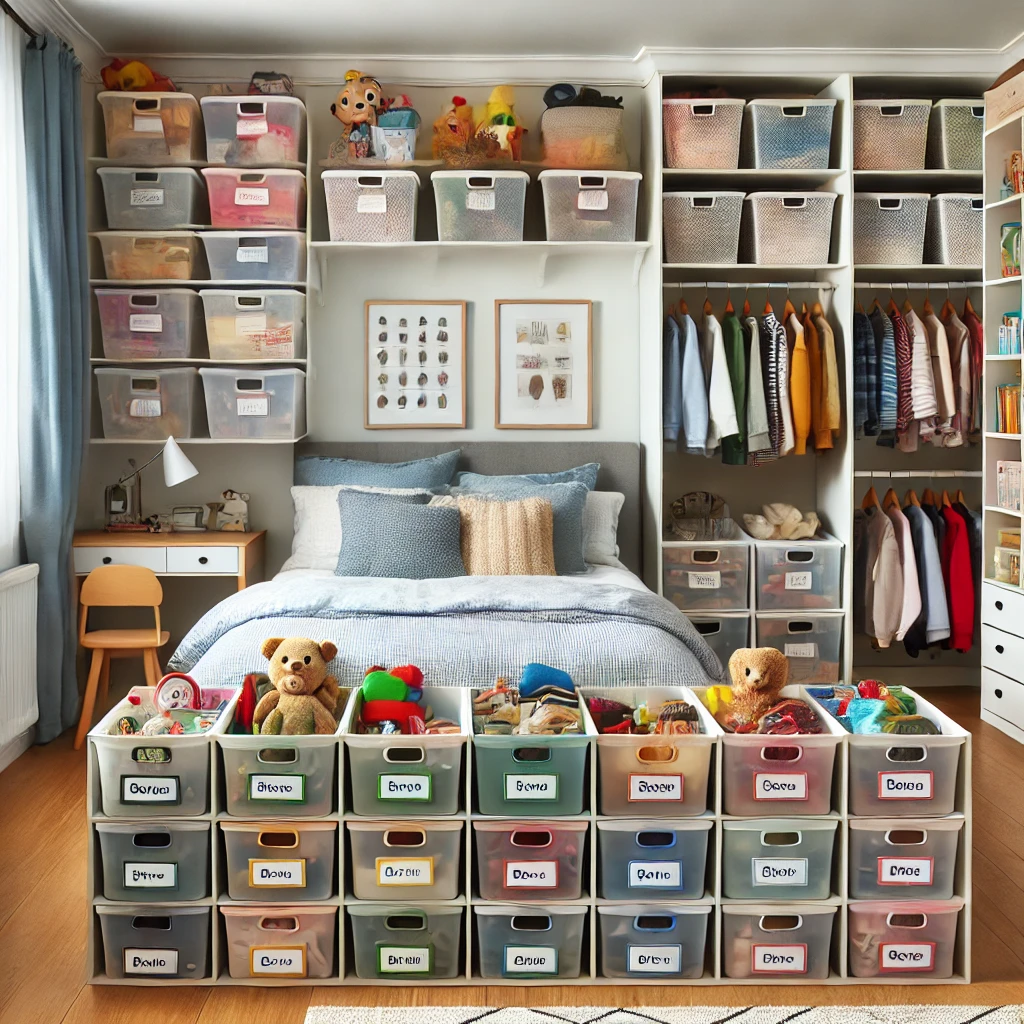
Shared bedrooms can quickly become messy if storage isn’t properly managed. Giving each sibling their own designated storage bins helps keep their belongings organized and separate. These bins can be placed under beds, in closets, or on shelves for easy access.
Labeling the bins with each child’s name or color-coding them can make it easier to identify personal items. This prevents mix-ups and encourages responsibility in keeping their own things tidy. Clear bins allow younger kids to see what’s inside without needing to open each one.
Multi-compartment storage units with labeled baskets work well for organizing toys, books, and school supplies. Having an assigned spot for everything helps reduce clutter and arguments over misplaced items. Organized storage makes the shared room more functional and peaceful.
Section 3: Fun & Playful Décor Enhancements
11. Interactive Wall (Chalkboard or Whiteboard Paint)
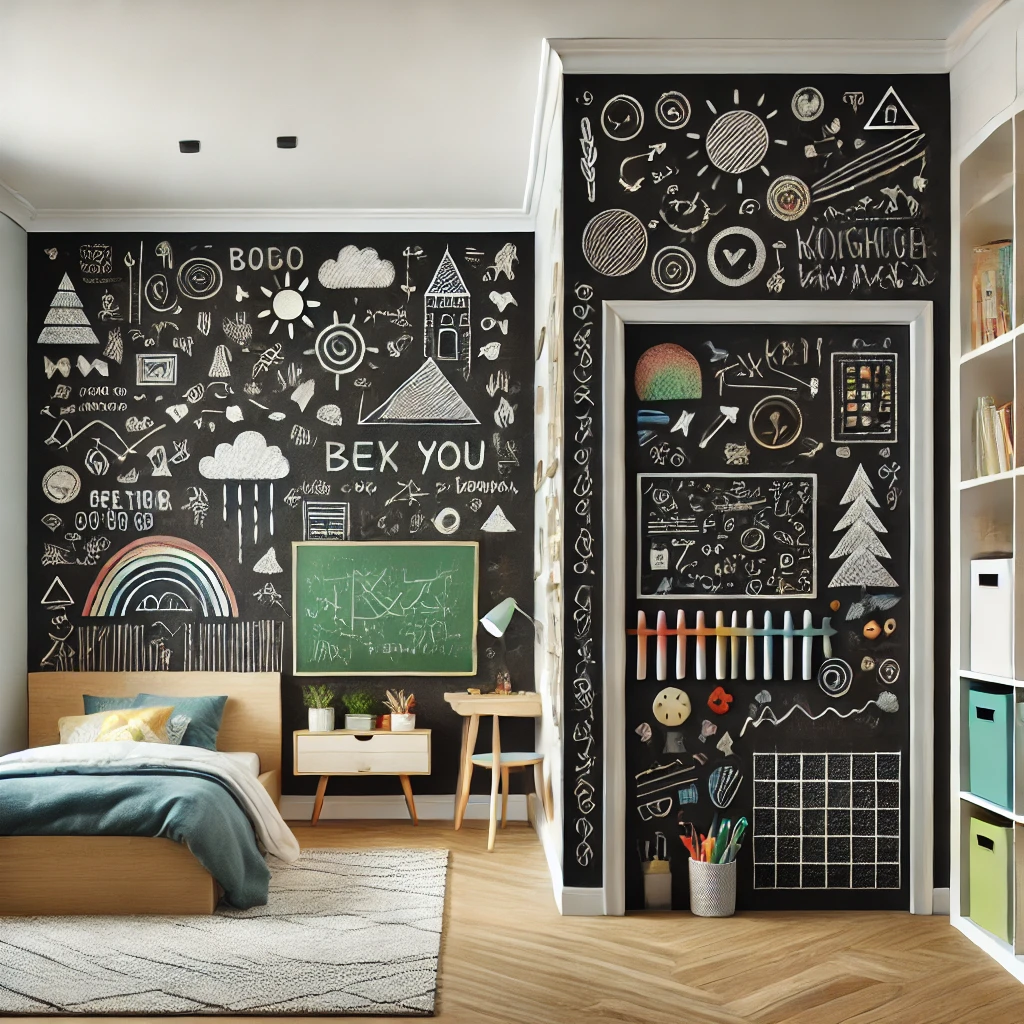
An interactive wall adds a fun and creative touch to a shared bedroom. Using chalkboard or whiteboard paint on one section of the wall allows siblings to draw, write messages, or practice schoolwork. This turns the wall into an ever-changing canvas for creativity.
Chalkboard paint comes in different colors, so each sibling can have their own section. They can use it to jot down reminders, play games, or even leave notes for each other. This feature encourages both artistic expression and communication between siblings.
For a more structured look, a framed whiteboard or corkboard can be mounted on the wall. This can be used to pin schedules, artwork, or inspirational quotes. An interactive wall is a fun and practical addition to any shared room.
12. DIY Photo Wall of Sibling Memories
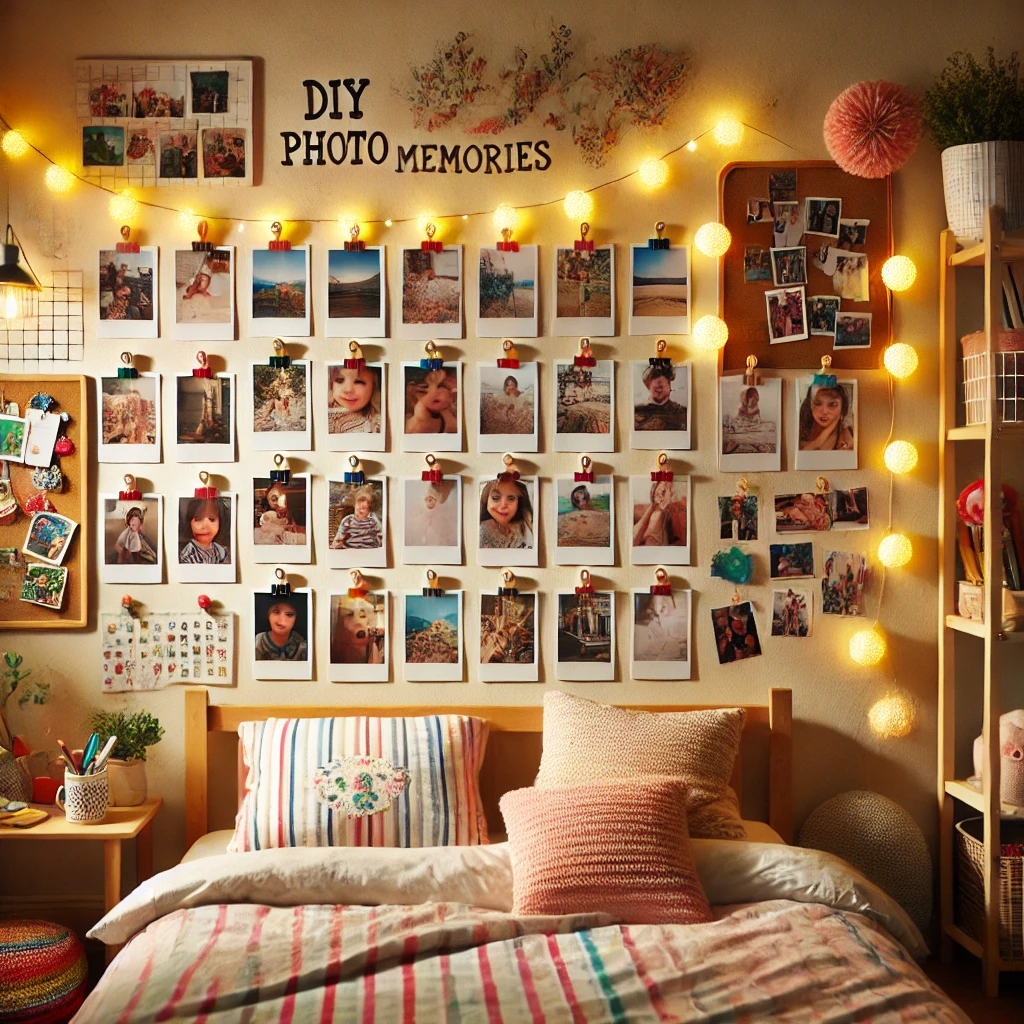
A photo wall is a beautiful way to celebrate the sibling bond. Hanging up pictures of childhood memories, vacations, and special moments makes the room feel personal and warm. This display can be created using string lights with clips, photo frames, or a collage board.
Encouraging siblings to choose their favorite photos together makes the process more meaningful. They can add fun elements like handwritten notes, stickers, or small souvenirs from their adventures. This makes their shared space feel like a reflection of their journey together.
If wall space is limited, a rotating photo album on a small shelf can serve the same purpose. This allows siblings to update their display with new pictures over time. A DIY photo wall adds warmth and nostalgia to their shared room.
13. Glow-in-the-Dark Ceiling Stars

Adding glow-in-the-dark stars or constellations to the ceiling creates a magical nighttime experience. This simple but enchanting décor idea makes bedtime more exciting for young siblings. It also provides a comforting glow for those who don’t like complete darkness.
Star stickers can be arranged into constellations, favorite shapes, or random patterns. Some kits even come with moon decals, planets, or shooting stars for a more cosmic effect. This makes the room feel dreamy and encourages an interest in astronomy.
To enhance the effect, consider adding soft LED string lights around the room. These can act as a nightlight while maintaining the magical glow. Glow-in-the-dark décor adds a sense of wonder to a shared bedroom.
14. Cozy Reading Nook with Shared Bookshelf

A cozy reading nook is a great addition to a shared bedroom, especially for book-loving siblings. Setting up a small corner with comfy bean bags, floor cushions, and a soft rug creates a relaxing space for reading. This area can also be used for storytelling or quiet time.
A shared bookshelf encourages siblings to swap books and discuss their favorites. Organizing books by color or genre makes the space visually appealing and easy to use. Each child can have their own shelf section while sharing the overall collection.
Adding fairy lights or a canopy can make the nook feel even cozier. Personal touches like framed book quotes or a nameplate for the reading corner make it more special. A well-designed reading nook fosters a love for books and strengthens sibling bonding.
Section 4: Functional & Stylish Accessories
15. Matching or Complementary Bedding Sets
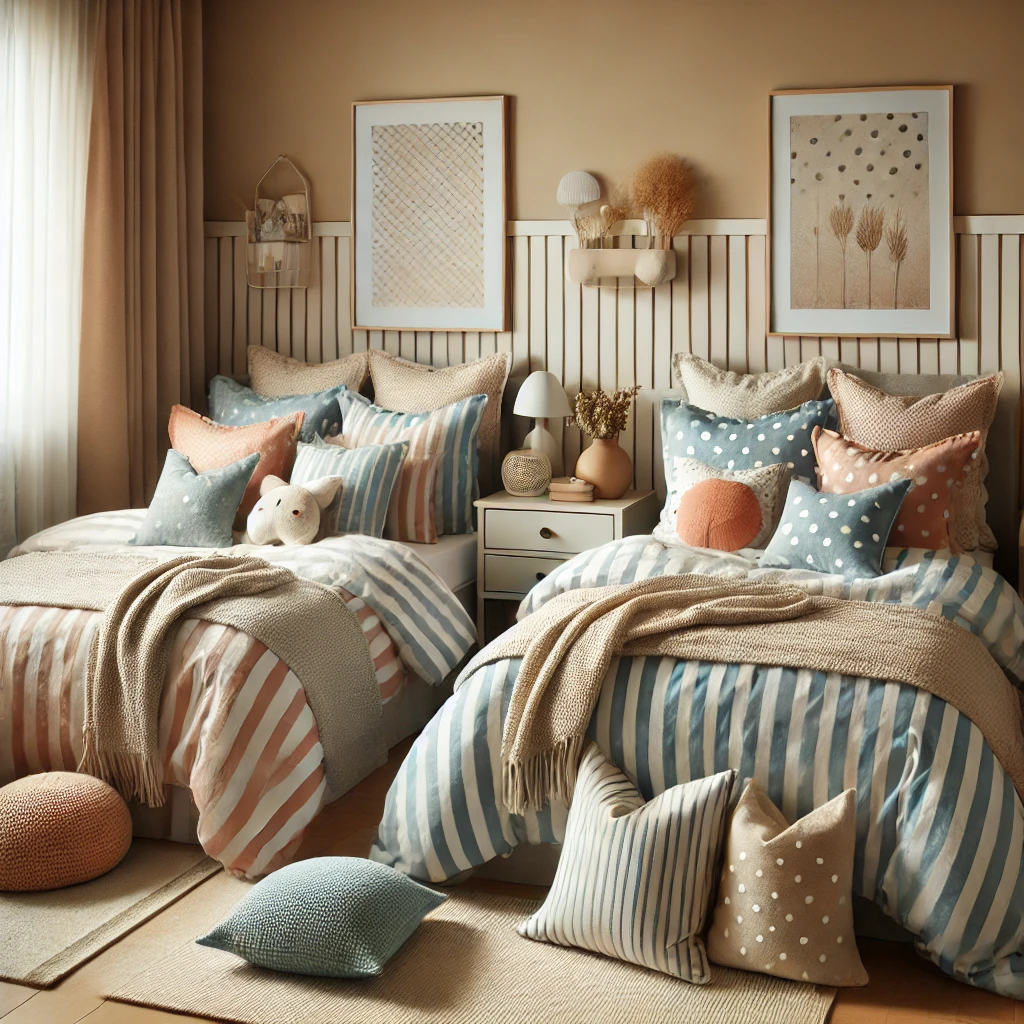
Choosing matching or complementary bedding helps create a cohesive look while allowing individuality. Siblings can pick different designs within a similar color scheme, ensuring a harmonious yet personal feel. This balance makes the room look stylish and well-coordinated.
For example, one child might prefer stripes while the other likes polka dots, but both can be in the same color palette. This keeps the room visually appealing without feeling too uniform. Bedding sets that reflect their personalities make the space feel like home.
Layering with throw blankets and decorative pillows allows for more customization. Each sibling can add their own favorite accents without clashing with the overall theme. Matching bedding creates a visually appealing and unified shared bedroom.
16. Personalized Throw Pillows or Blankets

Personalized décor items, like custom throw pillows or blankets, make a shared room feel extra special. These can feature initials, favorite characters, or inspirational quotes that reflect each sibling’s personality. Soft accessories like these add warmth and individuality.
Siblings can choose their own color or design while still fitting within the room’s overall theme. Monogrammed pillows or embroidered blankets add a personal touch without taking up extra space. This is an easy way to balance shared and individual elements in the room.
DIY pillow decorating can also be a fun sibling activity. Fabric markers, iron-on patches, or custom prints allow each child to create something unique. Personalized soft furnishings make the room feel cozy and special.
17. Fun Rugs to Define Spaces
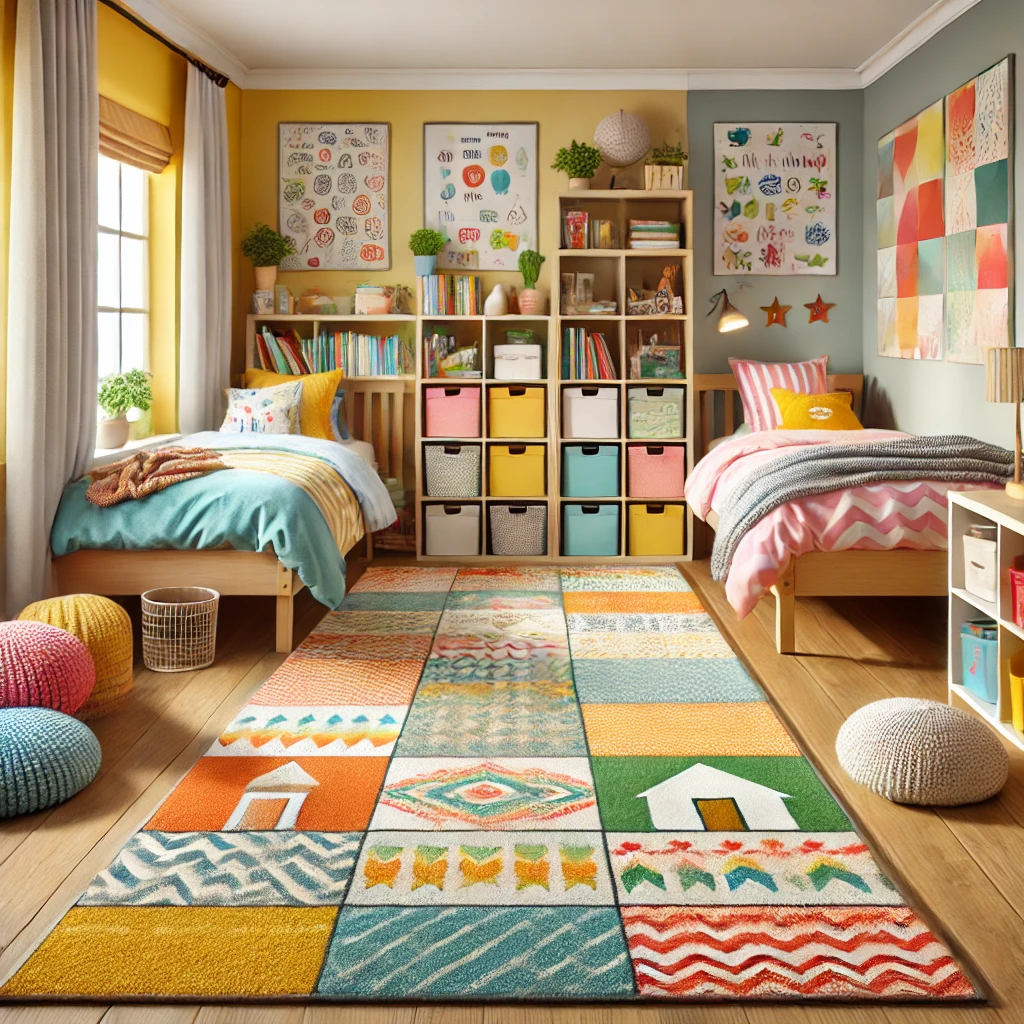
Area rugs help define personal spaces within a shared bedroom. Placing two small rugs near each sibling’s bed or study area visually separates their zones. This subtle design trick makes the room feel more balanced and organized.
Rugs with playful patterns or favorite themes add personality to the room. Choosing soft, comfortable textures makes the space inviting and cozy. If the room is small, a single large rug with a neutral design can tie everything together.
Foam puzzle mats are a great alternative for younger siblings, as they provide a safe play surface. Rugs not only enhance décor but also help with noise reduction, making the room feel more comfortable. A well-chosen rug brings warmth and character to a shared bedroom.
18. Fairy Lights or LED Strips

Lighting plays a crucial role in setting the mood of a shared bedroom. Fairy lights or LED strips add a cozy and playful atmosphere. These lights can be draped over beds, along walls, or around desks for a soft glow.
Color-changing LED strips allow siblings to customize the lighting according to their mood. They can choose different settings for bedtime, study time, or playtime. This adds a fun and interactive element to the room.
String lights shaped like stars, hearts, or animals add a whimsical touch. Using battery-operated options ensures safety, especially for younger kids. Creative lighting makes the shared bedroom feel magical and inviting.
Conclusion
Transforming a shared sibling bedroom can be both fun and functional. By combining smart storage solutions, personalized décor, and creative enhancements, you can create a space that feels unique to each child while promoting harmony. A well-designed room fosters independence, teamwork, and sibling bonding.
These 18 ideas provide a mix of practical and decorative solutions for any shared bedroom setup. Whether it’s adding bunk beds, personalized wall art, or cozy lighting, small changes can make a big difference. Celebrate Siblings Day by giving their room a makeover that they’ll love!

